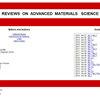高熵合金:高熵合金:作为有前途的储氢和熔盐材料的性能综述
IF 3.6
4区 材料科学
Q2 MATERIALS SCIENCE, MULTIDISCIPLINARY
引用次数: 0
摘要
化石燃料一直是最常用的能源,其消耗量持续增长;然而,化石燃料将被可再生能源(RES)所取代。大规模使用这种能源需要新材料,尤其是金属材料,因为传统材料的性能较差。特别是,从可再生能源中获取氢气存在吸收/解吸循环、动力学和成本等技术问题。同样,太阳能产业也需要在高温下具有高度耐腐蚀性的材料。如上所述,高熵合金(HEAs)可以解决这些问题。高熵合金问世不到 15 年,由于其不同寻常的机械、物理和化学性质,已被广泛应用于技术和科学领域。因此,本研究总结了 HEAs 作为氢和能源熔盐存储技术的理想材料所取得的进展,并讨论了当前 HEAs 的腐蚀性能,同时考虑了微观结构和组成元素的影响。本文章由计算机程序翻译,如有差异,请以英文原文为准。
High-entropy alloys: A review of their performance as promising materials for hydrogen and molten salt storage
Fossil fuels have been the most employed energy source with a consistent and growing consumption; however, they will be replaced by renewable energy sources (RESs). Massively using this type of energy will require new materials, especially metallic-based materials, because the typical materials have shown poor performance. In particular, hydrogen obtained from RESs has technological concerns like absorption/desorption cycling, kinetics, and cost. Similarly, the solar industry demands highly corrosion-resistant materials at high temperatures. As mentioned above, these could be solved using high-entropy alloys (HEAs). HEAs are barely around 15 years old and have been intensively investigated to be used for wide technological and scientific applications due to their unusual mechanical, physical, and chemical properties. Thus, this study summarizes advances in HEAs as promising materials for hydrogen and energy molten salt storage technologies and discusses the corrosion performance of current HEAs, considering both the microstructure and constituent element effect.
求助全文
通过发布文献求助,成功后即可免费获取论文全文。
去求助
来源期刊

Reviews on Advanced Materials Science
工程技术-材料科学:综合
CiteScore
5.10
自引率
11.10%
发文量
43
审稿时长
3.5 months
期刊介绍:
Reviews on Advanced Materials Science is a fully peer-reviewed, open access, electronic journal that publishes significant, original and relevant works in the area of theoretical and experimental studies of advanced materials. The journal provides the readers with free, instant, and permanent access to all content worldwide; and the authors with extensive promotion of published articles, long-time preservation, language-correction services, no space constraints and immediate publication.
Reviews on Advanced Materials Science is listed inter alia by Clarivate Analytics (formerly Thomson Reuters) - Current Contents/Physical, Chemical, and Earth Sciences (CC/PC&ES), JCR and SCIE. Our standard policy requires each paper to be reviewed by at least two Referees and the peer-review process is single-blind.
 求助内容:
求助内容: 应助结果提醒方式:
应助结果提醒方式:


